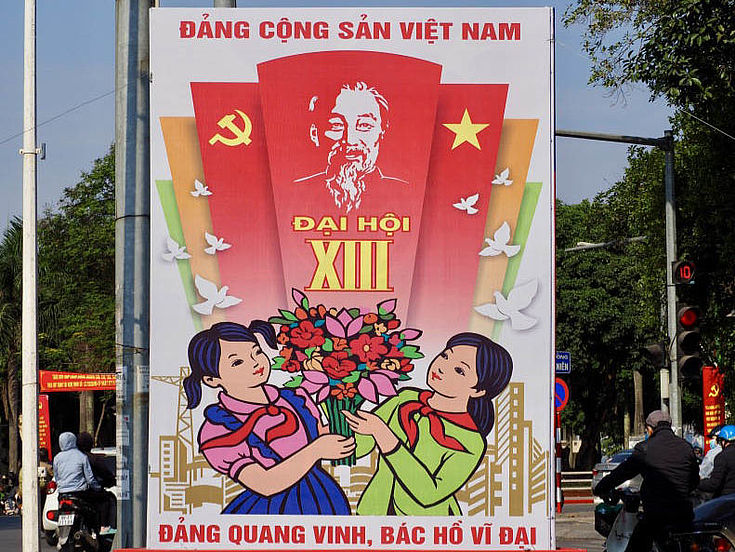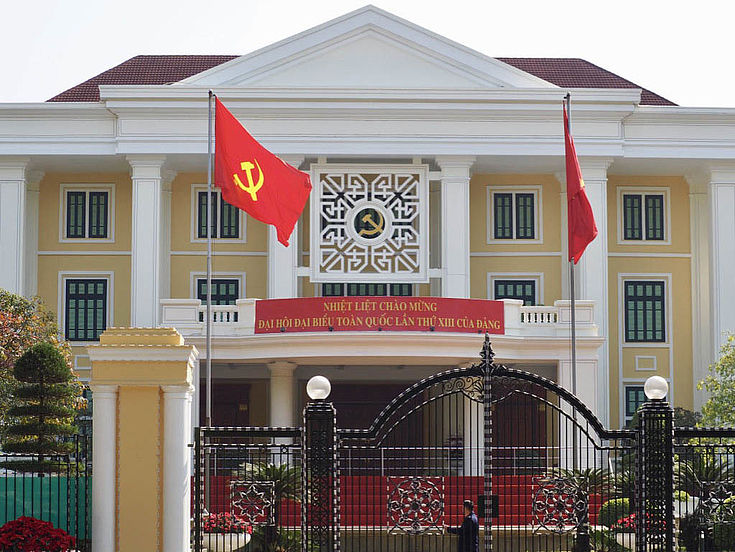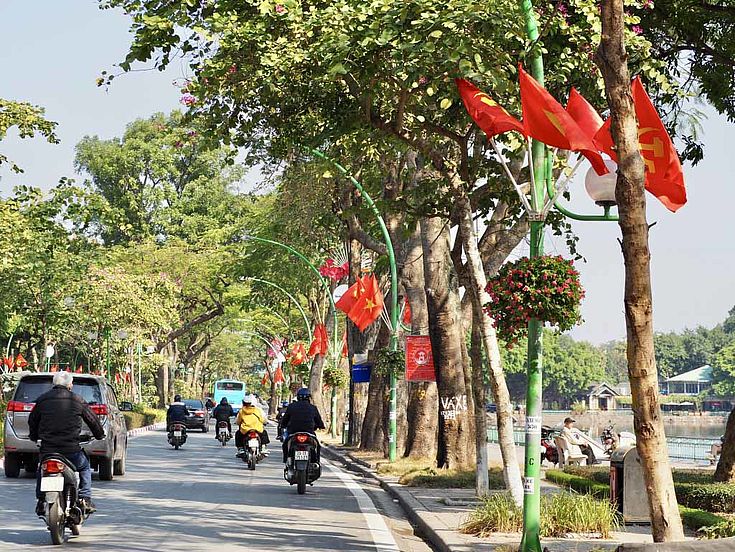National Party Congress to open in Vietnam
Vietnam ahead of the National Congress of the Communist Party of Vietnam with important decisions on the agenda
Looking at the city, one which is continuously growing, filled with shopping centers, skyscrapers and expensive cars, makes it hard to believe that Vietnam is a socialist country. The preparation for the National Congress and the ubiquity of the Communist Party of Vietnam (CPV) are pushing a reminder that it is a one-party system. For more than 70 years, the CPV has been in power, making it one of the longest continuously ruling parties in the world. More than 5 million people are members of the CPV and once every 5 years chosen representatives come together for the National Congress – one if not the most important political events in Vietnam.
In 1935, the CPV came together for the first time - at that time still in China, with the 3 main goals of developing and strengthening the Communist Party, promoting mass mobilization and expanding propaganda against imperialism. Since 1976, one year after the end of the so-called Vietnam War (in Vietnam: American War), the National Congress has taken place every 5 years. In 2021, the CPV cadres will meet for the 13th time, however its traditional value is not the only reason why the National Congress is currently so relevant. During the congress, decisions will be made on the most important political leadership positions, the socio-economic development strategy from 2021 to 2030 and the development of policy goals for the next five years.
Propaganda posters such as the one in Ba Dinh, Hanoi, praise the Communist Party of Vietnam.
HSF
Who elects who?
The power within the party is organized by certain bodies and committees that undertake different responsibilities. Who actually makes the political decisions is a complicated question due to the overlapping responsibilities of the party apparatus and the government.
Vietnam has a collective leadership structure based on four pillars: The State President, the Prime Minister, the Chairperson of the National Assembly and the Secretary General of the CPV are the political leaders and thus the most important and powerful political positions in Vietnam. Each of these four positions is filled by one politician and together they form the leadership elite. This leadership elite, in turn, governs in consultation with the Politburo, the highest body of the CPV. The Politburo determines the general direction of government and issues guidelines that are approved either during the National Party Congress or by the Central Committee. The members of the Politburo are appointed right after the National Party Congress by the Central Committee.
What happens during the National Congress?
The National Congress is not a stand-alone event. Politicians and the party prepare for the congress months in advance. Elections are held within the party apparatus at all administrative levels of government which contains central, provincial, district and commune level. Approximately 1,500 to 1,600 party delegates were elected during this process and will convene in Hanoi for the National Congress to announce the total 200 members of the CPV Central Committee. The Central Committee consists of 175 ordinary and 25 alternate members. It then elects the 17 to 19 members of the Politburo and, from this group, the General Secretary of the party. The President is appointed by the National Assembly and elects in consultation with the members of the National Assembly the Prime Minister. The Chairperson of the National Assembly is also elected by its members. The official confirmation of these positions will take place later this year in the National Assembly, which will be elected in May. By electing the Politburo, the Central Committee has a decisive influence on the distribution of political power in Vietnam as well as the political direction for the 5 next years.
According to the incumbent President and at the same time General Secretary of the CPV, Nguyen Phu Trong, the new Central Committee should be composed of an appropriate and representative ratio. This could be understood as a hint that more female and younger members as well as different ethnic groups and various professional groups should and will be represented in the new composition of the Central Committee. Both the composition of the Central Committee as well as the winning candidates of the top positions will be officially announced during the Congress.
At this point in time, it is not yet clear who will hold which office. A peculiarity of the last term of office was that the positions of President and General Secretary were both held by one person. This made Nguyen Phu Trong one of the most powerful politicians in Vietnam’s post-colonial history. So far, only two other politicians have held such a position of power - one of them was Ho Chi Minh, who paved the way for Vietnam’s independence. It is not clear yet, whether Vietnam will return to its original 4-pillar structure with the 13th National Congress this year or keep the 3-pillar structure as it is. In the past weeks there have been a lot of rumors and debates in political and diplomatic circles in Hanoi about potential appointments. Will the 76-year-old Trong pursue another full or partial third time as President or General Secretary? The possibility cannot be ruled out; however, this would imply that the party statutes would have to be changed or exceptions being made. Right now, the official limit is 65. However, if you look at the occupations of the last National Congresses, it is noticeable that exceptions to the age limit in Vietnam would not be a first-time development. Forcing out all these politicians could be problematic for the party’s capacity and is therefore extremely unlikely. Meanwhile, possible successors have been positioning themselves for months and have been asserting themselves within the party. Tran Quoc Vuong, 67, a close confidante of Trong and his right-hand man in the anti-corruption campaign he initiated, or the current Prime Minister Nguyen Xuan Phuc, 66, who showed a strong performance in the fight against covid-19 are candidates as successors to the office of Secretary General. The latter's position could be taken over by the current finance minister, Vuong Dinh Hue, 63, who is however also said to be a candidate for the position of Chairman of the National Assembly. Another strong candidate for this office is Truong Thi Mai, 62, who could be the second consecutive female Chair of the National Assembly. Finally, current Vice Prime Minister and Foreign Minister Pham Binh Minh, 61, is considered a possible candidate for the post of President. The impression that there is a constant struggle within the CPV between ideological hardliners and politically more progressive forces, probably falls short here. Ultimately, those cadres who have been able to network most successfully in recent months and years will win the race.
All important political buildings in Hanoi invite to the quinquennial event, the National Congress.
HSF
Political consequences of the National Congress
The National Party Congress has always played an enormous role in the general political climate in Vietnam. Not only is the motivation of the congress choosing the new political leaders for the following five years, it also gives the party the opportunity to change or tighten its political direction within its own structure. For example, in the aftermath of the last party congress in 2016, an anti-corruption campaign was initiated that was followed by numerous disciplinary proceedings against some officials. More recently, with the implementation of a cybersecurity law in the beginning of 2019, the control of the content published on the Internet is also being extended. This phenomenon intensified during the Covid-19 measures when the government sought to prevent the spread of fake news and rumors regarding the coronavirus.
Ahead of the congress, there are also signs for political innovation. For example: 43 percent of the new party provincial party chiefs are under 50 years old. They occupy the largest section in the Central Committee and will play an important role in directing and shaping the policy of the next term. This gives hope for moderate political and societal modernization. This development has been accompanied by efforts from the government and party to collect some public feedback on draft policy documents to be submitted to the upcoming congress. In addition, direct voting has been tried for the first time for the party delegates at 11 percent of the commune and district levels. This could mean that in the future the National Party Congress will also distance itself from the maxim of democratic centralism and no longer just have a small number of party members who have a say in the personal decision for the top positions and thus in the political future of Vietnam.
Effect of the National Congress on Vietnam’s foreign policy relations
Last year was a particularly challenging year for Vietnam. The country is heavily dependent on exports and tourism, and the Corona crisis had devastating effects not only on the economy, but also on Vietnam's social policy. At the same time, 2020 was also an incredibly significant year for the country. With the ASEAN chairmanship and the membership in the UN Security Council, two extraordinary responsibilities fell on Vietnam`s shoulders. Its comparatively small diplomatic apparatus successfully took over this dual role and Vietnam was able to strengthen its influence both in the region and beyond. Two foreign policy achievements that were particularly important against the background of the Corona crisis also occurred in 2020.
Not only was the relationship between the EU and ASEAN upgraded to a strategic partnership, but one of the most important trade agreements, the European Vietnam Free Trade Agreement (EVFTA), has also been ratified between Vietnam and the EU. This makes the Vietnam the only Southeast Asian country besides Singapore to have such an important trade pact with the EU. The EU is one of the most important sales markets for Vietnam. A significant increase in trade is expected because of the agreement and especially with its covid-19 recovery strategy. Regardless of the outcome of national congress, no major change in relations with Europe is therefore to be expected and the advancing regional and international integration will likely continue to determine the foreign policy agenda of Vietnam.
Of greater foreign policy interest, however, will be the course of the Vietnamese government towards the increasingly aggressive behavior of its neighbor country China. The filling of the top positions plays a much more important role here. Will the position be filled with China-friendly cadres? Solidarity with the “big brother” in the north could be given more attention in political decisions than anti-Chinese sentiments in the population. Vietnam depends on China for key materials and equipment for its supply chains. Vietnam, however also must moderate the aggressive behavior of China in the South China Sea (in Vietnam: East Sea) while at the same time, Vietnam's foreign policy is dependent on a good and peaceful relationship with China. Which direction Hanoi will follow in the future, largely depends on the relationship and the attitude of the new leadership elite towards China - a development that everyone in Vietnam is following closely.
Another powerful partner of Vietnam is the United States of America – a relationship that is also influenced by the actions of China. Vietnam did indeed have sympathy for the now former US President Donald Trump, not least because he seemed to take active steps against the superpower China. The trade war between China and the US has given Vietnam more international attention as a potential target for Foreign Direct Investment flows moving out of China. At the same time, the US Treasury designated Vietnam as currency manipulator against the background of an increasing trade deficit between the two countries. Whoever assumes the top leaderships in Vietnam will therefore have to deal with a lingering conflict that could escalate tensions with the US. Though, the foreign policy relationship between the US and Vietnam seems to depend at least as much on the new US president Joe Biden as on the new ruling elite of Vietnam. Trump recently canceled important trade agreements between Vietnam (as well as the whole region) and the United States. To what extent Biden will again promote economic relations with Vietnam or to what extent he will continue the trade conflict will be shown in the coming weeks and months.
The streets of Hanoi are decorated with Vietnam Flags – during the Congress even more than usually.
HSF
Conclusion
Whatever the outcome of the congress will be – an abrupt political or economic change of direction by the CPV leadership is by no means on the table. Still, different political leaders will follow different social, economic, and domestic as well as foreign policy scenarios.
While the personnel issues discussed above will of course play a crucial role in Vietnamese domestic and foreign policy in the coming years, substantive political and strategic decisions have been in preparation for months. It will be exciting to see how the country's new (and possibly old) leadership elites will fulfill the long-term strategic decisions. At the 13th National Congress from January 25 to February 2, 2021, the course is being set.
About the author:
Magdalena Knödler studied International Cultural and Business Studies with focus on Southeast Asian studies at the University of Passau, Germany. She now works as a freelance consultant. The opinions stated in this article are the ones by the author and do not necessarily express the views of Hanns Seidel Foundation or its staff.



